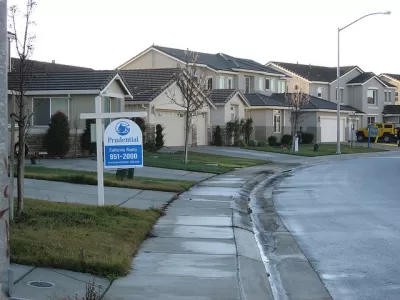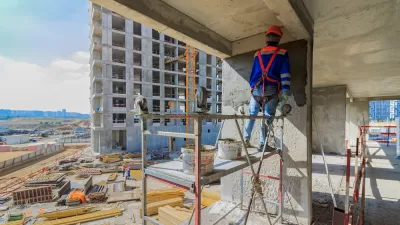In a new article, Penn IUR Fellow Joseph Tracy and Penn IUR Co-Director Susan Wacther write about the imperative of rebuilding the housing finance system.

By Susan M. Wachter and Joseph Tracy
In the fall of 2008, the world watched in horror as the U.S. housing finance system shattered, triggering a global financial panic and ultimately the Great Recession. Now, nearly a decade later, the long and slow recovery has reached a critical moment. Though the housing finance system has stabilized, it remains in the hands of the federal government, leaving taxpayers, rather than private capital, largely exposed to the credit risk. Fannie Mae and Freddie Mac—the government-sponsored enterprises (GSEs) responsible for most of the country’s residential mortgage securitization—continue to be held in conservatorship by the Federal Housing Finance Agency (FHFA). Meanwhile, private funding remains mostly on the sidelines, with the source of ongoing financing necessary for sustainable, affordable homeownership still unknown. An eager young generation is unable to access the credit or afford the down payments necessary to successfully transition from renting to owning. This lingering inertia is a critical weakness in the American economy. The system must be rebuilt.
Housing finance reformers have not been short of options. In the wake of the Great Recession, proposals have arisen across the political spectrum, spanning the range from immediate privatization to complete government takeover, center(ing) around four points of consensus.
First, the thirty-year fixed-rate mortgage should remain available as a source of funding for households, correctly priced for risk. This mortgage allows households to own and hedge rent increase risk while also hedging interest rate risk. The mortgage product shifts that risk to capital markets, which are better equipped to manage rate risk than households. This mortgage is also simple to understand and to evaluate in terms of the household’s ability to pay. To ensure this, the to-be-announced (TBA) market, is necessary to ensure a liquid secondary outlet, without which originators would be far less willing to issue this type of loan. This liquid secondary outlet helps to keep this mortgage affordable.
Second, borrowers followed by private capital must take the first losses when mortgages default. Market discipline is necessary to prevent borrowers, originators, and MBS investors from taking excessive risks. Equally important, however, is government support for catastrophic losses that the private market cannot sustain without total collapse. In contrast to the past, this support should be priced going forward.
Third, securitization must operate in daylight with some form of standardization—on a common, transparent platform where investors and regulators can obtain information for pricing. All participants must understand the risks involved in securitization, unlike the information asymmetries that allowed underpriced credit to fuel the latest housing bubble.
Fourth, the government should not abandon its policy of encouraging affordable housing by simply leaving the free market to its own devices. Across the country, rapidly rising rents and tightened underwriting standards have combined to make the cost of housing a significant strain on the budgets of an American middle class that is already suffering from decades of income stagnation and is still struggling to deleverage. However, government efforts to support affordable mortgages must also ensure that they are sustainable.
These principles must be implemented through a newly structured system that is sustainable with fundamental restructuring for stability. To this end, the authors in this book present proposals for long-term structural reforms. Each chapter suggests reforms that would infuse new life into our housing finance system as well as providing long-term stability.
Susan M. Wachter is Co-Director of Penn IUR and Albert Sussman Professor of Real Estate, Professor of Finance, the Wharton School. Joseph Tracy is Executive Vice President and Senior Advisor to the President, Federal Reserve Bank of NY. This article is adapted from the authors' new book, Principles of Housing Finance Reform.
FULL STORY: Principles of Housing Finance Reform: The Imperative of Rebuilding the System

Alabama: Trump Terminates Settlements for Black Communities Harmed By Raw Sewage
Trump deemed the landmark civil rights agreement “illegal DEI and environmental justice policy.”

Planetizen Federal Action Tracker
A weekly monitor of how Trump’s orders and actions are impacting planners and planning in America.

The 120 Year Old Tiny Home Villages That Sheltered San Francisco’s Earthquake Refugees
More than a century ago, San Francisco mobilized to house thousands of residents displaced by the 1906 earthquake. Could their strategy offer a model for the present?

Indy Neighborhood Group Builds Temporary Multi-Use Path
Community members, aided in part by funding from the city, repurposed a vehicle lane to create a protected bike and pedestrian path for the summer season.

Congestion Pricing Drops Holland Tunnel Delays by 65 Percent
New York City’s contentious tolling program has yielded improved traffic and roughly $100 million in revenue for the MTA.

In Both Crashes and Crime, Public Transportation is Far Safer than Driving
Contrary to popular assumptions, public transportation has far lower crash and crime rates than automobile travel. For safer communities, improve and encourage transit travel.
Urban Design for Planners 1: Software Tools
This six-course series explores essential urban design concepts using open source software and equips planners with the tools they need to participate fully in the urban design process.
Planning for Universal Design
Learn the tools for implementing Universal Design in planning regulations.
Clanton & Associates, Inc.
Jessamine County Fiscal Court
Institute for Housing and Urban Development Studies (IHS)
City of Grandview
Harvard GSD Executive Education
Toledo-Lucas County Plan Commissions
Salt Lake City
NYU Wagner Graduate School of Public Service





























